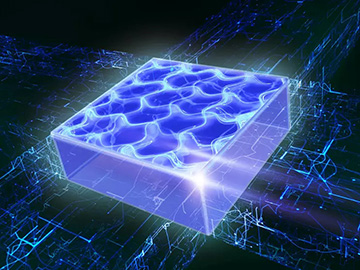
An artist’s impression of a 2D supersolid created by exploiting the attractive and repulsive interactions between ultracold magnetic dysprosium atoms. [Image: Harald Ritsch]
Supersolids are counterintuitive materials that combine the regular crystal structure of solids with the ability of superfluids to flow without resistance. Researchers have already demonstrated that they can create these materials by exploiting the exotic properties of ultracold atomic gases, although only in one dimension. Now a group in Austria has extended such a system to 2D, using a gas of magnetic dysprosium atoms in an optical trap (Nature, doi: 10.1038/s41586-021-03725-7).
Two routes to supersolids
Predicted by Russian physicists in the 1960s, supersolids have an apparently paradoxical nature. On the one hand they involve atoms being localized at discrete points within a crystal lattice. On the other, they depend on those same atoms being spread out in space as part of the single quantum state that is characteristic of a superfluid.
One natural medium for a supersolid is a collection of helium-4 atoms at cryogenic temperatures, since those atoms can exist in either the solid or superfluid phase, depending on the applied pressure. The idea is to start with a solid and introduce superfluid properties. Despite the obvious appeal of such a system, however, no one has yet convincingly shown they can create supersolids in this way (although one group previously claimed to have done so).
The use of ultracold atomic gases, which are created at less than a millionth of a degree above absolute zero, involves the opposite, more flexible, route: starting with a superfluid and inducing a crystalline structure within it. More specifically, the idea is to exploit the characteristics of Bose-Einstein condensates. These are quantum states of matter now made regularly in laboratories, consisting of a dilute gas of bosonic atoms so cold that all the particles drop into the same quantum state and act in unison.
In 2017, two groups reported having created supersolids by exposing atoms in a condensate to laser light such that the particles organized themselves into arrays while maintaining a superfluid state. However, because the systems’ lattice spacing was set by the laser’s wavelength, the crystals could not vibrate like a conventional solid and so lacked degrees of freedom that would be seen in a supersolid.
Exploiting magnetic atoms
Two years later, three groups showed how such a shortcoming could be overcome by making a condensate from magnetic atoms. The idea was to exploit attractive dipolar interactions between atoms aligned head-to-tail, as well as repulsive interactions arising both from atoms being side-by-side and in close contact. The interplay between these contrasting interactions leads to a regularly-spaced one-dimensional array of “droplets” of relatively high atomic density, surrounded by a fairly uniform and low density of gas that supports the synchronization characteristic of superfluidity.
The upshot is an atomic system arranged into an array whose spacing can vary just like a real solid, but which remains in a superfluid state. The droplets are therefore no ordinary agglomerations of matter, with each atom being housed in a specific droplet. Instead, each atom is spread out across all droplets—with droplets representing points in the superfluid wavefunction where atoms are more likely to be found if measured.
Extending to 2D
One of the groups that carried out this earlier research, led by Francesca Ferlaino at the Institute for Quantum Optics and Quantum Information in Innsbruck, has now shown how to extend such an array to two dimensions. They did so by creating a Bose-Einstein condensate of up to 65,000 dipolar dysprosium-164 atoms, held within an optical dipole trap that was formed by intersecting two detuned beams from a single infrared laser.
By applying a magnetic field and tuning the trap’s aspect ratio (the ratio of trap frequencies in the x and y directions), the researchers were able to induce a transition in the resulting droplets, changing their configuration from a linear to a zigzag array. This zigzagging introduced width into the lattice.
According to Bruno Laburthe-Tolra, who wrote a commentary piece to accompany the research, this demonstration of supersolid bi-dimensionality will enable the rotation that can reveal whether superfluidity really is present in the system. As he explains, the vortex present inside a superfluid would give a supersolid a slightly smaller moment of inertia than that of an ordinary solid.
Ferlaino and colleagues now intend to probe their system in more detail by employing a wider range of trap aspect ratios and investigating the role of defects. The idea, says lead author Matthew Norcia, also at the Institute for Quantum Optics and Quantum Information, is to explore the system at higher energies, as the group has thus far studied the atoms only in their lowest-energy configuration.
Correction, 30 August 2021: In a previous version of this story, the the second to last paragraph said that a supersolid would be expected to have a higher moment of inertia than an ordinary solid; in fact the moment of inertia of a supersolid would be expected to be slightly smaller. We apologize for the error.
